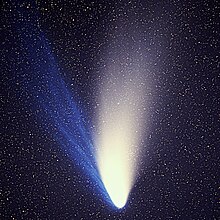 Global Information
Global InformationComet information
| Comet | |
|---|---|
 Comet Hale-Bopp | |
| Characteristics | |
| Type | Small solar system body |
| Found | Star systems |
| Size range | ~10 km wide (nucleus)[1] |
| Density | 0.6 g/cm3 (average) |
| External links | |
A comet is an icy, small Solar System body that warms and begins to release gases when passing close to the Sun, a process called outgassing. This produces an extended, gravitationally unbound atmosphere or coma surrounding the nucleus, and sometimes a tail of gas and dust gas blown out from the coma. These phenomena are due to the effects of solar radiation and the outstreaming solar wind plasma acting upon the nucleus of the comet. Comet nuclei range from a few hundred meters to tens of kilometers across and are composed of loose collections of ice, dust, and small rocky particles. The coma may be up to 15 times Earth's diameter, while the tail may stretch beyond one astronomical unit. If sufficiently close and bright, a comet may be seen from Earth without the aid of a telescope and can subtend an arc of up to 30° (60 Moons) across the sky. Comets have been observed and recorded since ancient times by many cultures and religions.
Comets usually have highly eccentric elliptical orbits, and they have a wide range of orbital periods, ranging from several years to potentially several millions of years. Short-period comets originate in the Kuiper belt or its associated scattered disc, which lie beyond the orbit of Neptune. Long-period comets are thought to originate in the Oort cloud, a spherical cloud of icy bodies extending from outside the Kuiper belt to halfway to the nearest star.[2] Long-period comets are set in motion towards the Sun by gravitational perturbations from passing stars and the galactic tide. Hyperbolic comets may pass once through the inner Solar System before being flung to interstellar space. The appearance of a comet is called an apparition.
Extinct comets that have passed close to the Sun many times have lost nearly all of their volatile ices and dust and may come to resemble small asteroids.[3] Asteroids are thought to have a different origin from comets, having formed inside the orbit of Jupiter rather than in the outer Solar System.[4][5] However, the discovery of main-belt comets and active centaur minor planets has blurred the distinction between asteroids and comets. In the early 21st century, the discovery of some minor bodies with long-period comet orbits, but characteristics of inner solar system asteroids, were called Manx comets. They are still classified as comets, such as C/2014 S3 (PANSTARRS).[6] Twenty-seven Manx comets were found from 2013 to 2017.[7]
As of November 2021[update], there are 4,584 known comets.[8] However, this represents a very small fraction of the total potential comet population, as the reservoir of comet-like bodies in the outer Solar System (in the Oort cloud) is about one trillion.[9][10] Roughly one comet per year is visible to the naked eye, though many of those are faint and unspectacular.[11] Particularly bright examples are called "great comets". Comets have been visited by uncrewed probes such as NASA's Deep Impact, which blasted a crater on Comet Tempel 1 to study its interior, and the European Space Agency's Rosetta, which became the first to land a robotic spacecraft on a comet.[12]
- ^ "Ask an Astronomer". Cool Cosmos. Retrieved 11 March 2023.
- ^ Randall, Lisa (2015). Dark Matter and the Dinosaurs: The Astounding Interconnectedness of the Universe. New York: Ecco/HarperCollins Publishers. pp. 104–105. ISBN 978-0-06-232847-2.
- ^ "What is the difference between asteroids and comets". Rosetta's Frequently Asked Questions. European Space Agency. Retrieved 30 July 2013.
- ^ "What Are Asteroids And Comets". Near Earth Object Program FAQ. NASA. Archived from the original on 28 June 2004. Retrieved 30 July 2013.
- ^ Ishii, H. A.; et al. (2008). "Comparison of Comet 81P/Wild 2 Dust with Interplanetary Dust from Comets". Science. 319 (5862): 447–50. Bibcode:2008Sci...319..447I. doi:10.1126/science.1150683. PMID 18218892. S2CID 24339399.
- ^ "JPL Small-Body Database Browser C/2014 S3 (PANSTARRS)".
- ^ Stephens, Haynes; et al. (October 2017). "Chasing Manxes: Long-Period Comets Without Tails". AAA/Division for Planetary Sciences Meeting Abstracts. 49 (49). 420.02. Bibcode:2017DPS....4942002S.
- ^ "Comets Discovered". Minor Planet Center. Retrieved 27 April 2021.
- ^ Erickson, Jon (2003). Asteroids, Comets, and Meteorites: Cosmic Invaders of the Earth. The Living Earth. New York: Infobase. p. 123. ISBN 978-0-8160-4873-1.
- ^ Couper, Heather; et al. (2014). The Planets: The Definitive Guide to Our Solar System. London: Dorling Kindersley. p. 222. ISBN 978-1-4654-3573-6.
- ^ Licht, A. (1999). "The Rate of Naked-Eye Comets from 101 BC to 1970 AD". Icarus. 137 (2): 355–356. Bibcode:1999Icar..137..355L. doi:10.1006/icar.1998.6048.
- ^ "Touchdown! Rosetta's Philae Probe Lands on Comet". European Space Agency. 12 November 2014. Retrieved 11 December 2017.